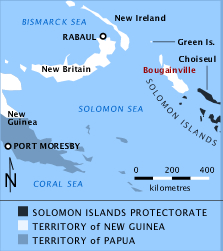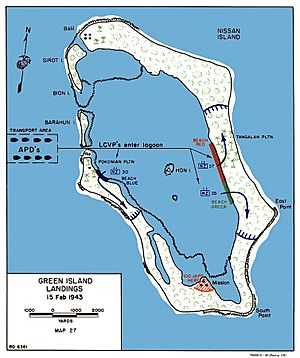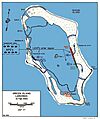Battle of the Green Islands facts for kids
Quick facts for kids Battle of the Green Islands |
|||||||
|---|---|---|---|---|---|---|---|
| Part of the Pacific Theater of World War II | |||||||
 Troops from New Zealand disembark from US Landing Craft Infantry ship LCI-444 to occupy Green Island on 16 February 1944. |
|||||||
|
|||||||
| Belligerents | |||||||
| Commanders and leaders | |||||||
| Strength | |||||||
| 5,806 | 120 | ||||||
| Casualties and losses | |||||||
| 13 killed 26 wounded |
120 killed, 12 aircraft destroyed |
||||||
The Battle of the Green Islands, also known as Operation Squarepeg, was a short but important fight during World War II. It happened from February 15 to 20, 1944. This battle involved Allied forces from New Zealand and the United States. They fought against Japanese forces.
The main goal was to capture Nissan Island in the Green Islands. New Zealand troops quickly secured the island. This victory was very important for the Allies. It helped them get closer to the main Japanese base at Rabaul. The Green Islands then became a key base for Allied planes and ships.
Contents
Why the Green Islands Were Important
The Green Islands are a group of small coral islands. They are located between Bougainville and New Ireland. These islands are about 150 miles (240 km) from Rabaul. Rabaul was a very strong Japanese military base.
At the time, the Green Islands were part of Papua New Guinea. About 1,200 local people lived there. The islands form a rough circle, with Nissan Island being the largest. Nissan has a big inner lagoon, which was perfect for ships.
The Allies wanted to keep pushing towards Rabaul. They had already landed troops on New Britain and Bougainville. The Green Islands were close enough for Allied fighter planes to protect. Capturing them would allow the Allies to launch more attacks on Rabaul.
Scouting the Islands
Before the main attack, a small group of Allied soldiers went to Nissan Island. On January 30, 1944, about 300 New Zealand and American troops landed. Their mission was to check how strong the Japanese forces were. They also looked for good landing spots for the main invasion.
The scouting party stayed for 24 hours. They met the local people, who gave them helpful information. The soldiers also patrolled the island to learn about the Japanese defenses. There were a few small fights. Four Allied soldiers were killed and five were wounded. After gathering information, the group returned by sea.
The Invasion Begins
The main invasion, called "Operation Squarepeg," started on February 15, 1944. It was led by Admiral William Halsey Jr. Allied forces sailed from Vella Lavella and the Treasury Islands. They landed on several islands, including Nissan Island.
The main ground troops were from the New Zealand 3rd Division. They were led by Major General Harold Barrowclough. The Japanese forces were much smaller, with only about 120 to 150 soldiers. Most of these were naval watchkeepers and army personnel. They had arrived by submarine earlier in February.
Allied Forces Arrive
The New Zealand soldiers traveled on US Navy ships. These ships were protected by a strong naval force. It included destroyers, minesweepers, and motor torpedo boats. American LSTs also brought Valentine tanks for support.
Many other units helped with the invasion. These included US Navy Seabee battalions, who are construction engineers. They would build bases after the fighting. US coastal artillery provided anti-aircraft defense. New Zealand engineers, artillery, and medical units also joined the landing.
As the Allied ships approached, Japanese planes from Rabaul attacked them. The landing ships were not hit. However, the cruiser St. Louis was damaged. Twenty-three sailors were killed and 28 were wounded. Later, more Japanese planes attacked the landing craft. But Allied fighter planes quickly shot them down. The Japanese lost 12 aircraft in total.
The landing itself went smoothly. Soldiers were taken ashore in smaller landing craft. They entered the lagoon and landed at different beaches. On February 15, about 5,800 Allied personnel landed. Over 4,200 of them were New Zealanders.
Fighting on Land
Once ashore, the Allies quickly set up a safe area. There was only brief resistance from some Japanese boats. Patrols were sent out, and supplies were moved inland. Headquarters were set up for the New Zealand troops.
On February 16, the New Zealand soldiers began moving across Nissan Island. Different battalions cleared different parts of the island. Each group had Valentine tanks to help them. The tanks provided close support and helped clear paths through the jungle.
There were several small fights. A group of about 70 Japanese soldiers was found near a Catholic mission. New Zealand infantry, supported by tanks, fought them for several days. Sixty-two Japanese soldiers were killed in this fight. Three New Zealanders were killed and 11 were wounded.
More fighting happened on February 19. The island was finally secured the next day. On February 23, the last action took place. A group of New Zealand soldiers cleared the small island of Sau. Fourteen Japanese survivors had hidden there. They refused to surrender and were defeated in a short fight. Four New Zealanders were wounded.
Overall, the Allies had 13 killed and 26 wounded. Almost all of the Japanese soldiers on the island were killed.
Building a Base
After the battle, the Seabees began building a military base. They started work on an airstrip on February 20. By March 6, a 5,000-foot (1,500 m) long airstrip was ready. Fighter planes based there began attacking Japanese targets.
Work continued on roads, taxiways, and other base facilities. A 6,000-by-150-foot (1,829 by 46 m) bomber strip was finished by the end of March. Building was hard because of bad weather and thick jungle. They also had to blast rocks and bring in coral for the runways.
The airstrips became home to United States Marine Corps planes. These planes helped cut off Japanese bases at Rabaul and Kavieng. New Zealand fighters also used the base to refuel. A special transport unit, SCAT, was also set up. It brought supplies and mail to soldiers and evacuated the wounded.
Lieutenant Richard Nixon, who later became President of the United States, worked with the SCAT unit here. Other facilities included a seaplane ramp and a fuel pier. A base for PT boats was also built. Medical facilities were set up in special huts.
In March 1944, over 1,100 local people were moved from the island. This was because there were food shortages as the base grew.
By May 1944, new airstrips were opened on Emirau Island. This made Nissan Island less important. Base construction was mostly finished by July 1944. The base was then slowly taken apart starting in late 1944.
Images for kids






